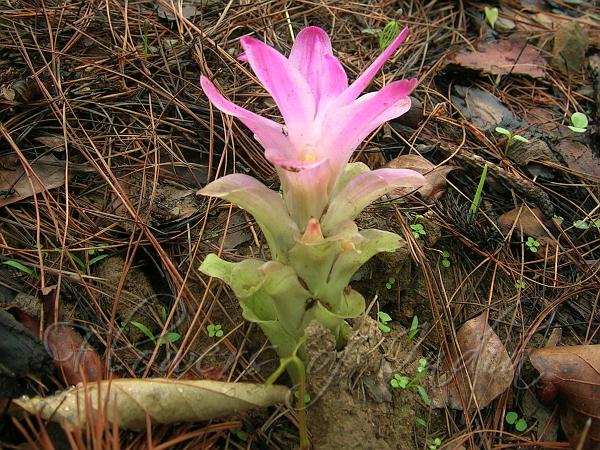|
| East Indian Arrowroot |
|

|

| File size | 775765 |
| Original date | 5/27/08 12:22 PM |
| Resolution | 1792 x 1344 |
| Flash | Flash did not fire, auto |
| Focal length | 5.4mm |
| Exposure time | 1/125s |
| Aperture | 2.8 |
| Focus Distance | |
| Metering Mode | Multi-segment |
| Camera make | NIKON |
| Camera model | E3700 |
| Sensor type |
|
|
|
Photo: |
Botanical name: Curcuma angustifolia Family: Zingiberaceae (Ginger family)
East Indian Arrowroot is an attractive ginger with stout underground rhizomes which lie
dormant in winters. In early spring the flowers are produced before the
leaves. Very colourful bracts make this a showy species. The shape and colour
of the bracts are very variable. The inflorescence lasts in full bloom on the
plants for about three weeks and more. Good for cut flower use with a vase
life of 10 days and more for fresh cut blooms. Leaves are about 30 cm long,
lanceshaped, and die down in autumn. In Manipur, pakodas made using
these flowers, are considered a delicacy. East Indian Arrowroot is found in
the Himalayas, from Kumaon to NE India and SE Asia, at altitudes of 900-1210 m.
Medicinal uses: East Indian Arrowroot is
recognized as a medical herb. It is nutritive, and is used as an
agreeable, non-irritating diet in certain chronic diseases, during
convalescence from fevers, in irritations of the alimentary canal, pulmonary
organs, or of the urinary apparatus, and is well suited for infants to supply
the place of breast-milk, or for a short time after having weaned them. It may
be given in the form of jelly, variously seasoned with sugar, lemon-juice,
fruit jellies, essences, or aromatics. Its jelly has no peculiar taste, and is
less liable to become acid in the stomach, and is generally preferred by young
infants to all others, except tapioca.
East Indian Arrowroot is
recognized as a medical herb. It is nutritive, and is used as an
agreeable, non-irritating diet in certain chronic diseases, during
convalescence from fevers, in irritations of the alimentary canal, pulmonary
organs, or of the urinary apparatus, and is well suited for infants to supply
the place of breast-milk, or for a short time after having weaned them. It may
be given in the form of jelly, variously seasoned with sugar, lemon-juice,
fruit jellies, essences, or aromatics. Its jelly has no peculiar taste, and is
less liable to become acid in the stomach, and is generally preferred by young
infants to all others, except tapioca.
Medicinal uses:
 East Indian Arrowroot is
recognized as a medical herb. It is nutritive, and is used as an
agreeable, non-irritating diet in certain chronic diseases, during
convalescence from fevers, in irritations of the alimentary canal, pulmonary
organs, or of the urinary apparatus, and is well suited for infants to supply
the place of breast-milk, or for a short time after having weaned them. It may
be given in the form of jelly, variously seasoned with sugar, lemon-juice,
fruit jellies, essences, or aromatics. Its jelly has no peculiar taste, and is
less liable to become acid in the stomach, and is generally preferred by young
infants to all others, except tapioca.
East Indian Arrowroot is
recognized as a medical herb. It is nutritive, and is used as an
agreeable, non-irritating diet in certain chronic diseases, during
convalescence from fevers, in irritations of the alimentary canal, pulmonary
organs, or of the urinary apparatus, and is well suited for infants to supply
the place of breast-milk, or for a short time after having weaned them. It may
be given in the form of jelly, variously seasoned with sugar, lemon-juice,
fruit jellies, essences, or aromatics. Its jelly has no peculiar taste, and is
less liable to become acid in the stomach, and is generally preferred by young
infants to all others, except tapioca.| Identification credit: Basantarani Haobam | Photographed in Manipur & Himachal Pradesh. |
• Is this flower misidentified? If yes,